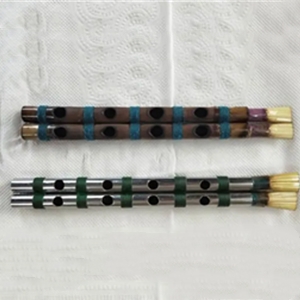Mimi overview

Mimi (pinyin: mī mī), a double-reed gas-sounding instrument of Hui, Dongxiang, Baoan, Sala, Tu, Yugu, Han and other nationalities, is popular in Linxia, Wudu, Gannan and Qinghai provinces.
Mimi is composed of two parts, a tube body and a tube whistle, with a total length of 14 cm. The tube body is made of bamboo, and is made up of two tube bodies with the same length, thickness, hole spacing and pitch tied side by side. The bamboo tube opens the middle bamboo joint, the upper and lower ends are open, the tube length is 13 cm, and the inner diameter of the tail end is 0.4 cm. The two pipes are respectively provided with the same four circular sound holes. The hole is 2.3 cm from the fourth hole, and the fourth hole is 2.8 cm from the head of the tube. The pipe whistle is made from the bark of a lilac tree or willow branch. First, cut the bark of the branch into small pieces and separate them from the wooden pole. This bark tube does not need to be processed. The outer diameter is 0.4 cm, and the bark whistle is inserted into the pipe openings on the upper ends of the two pipes respectively, and the exposed 1 cm is enough. The head and tail ends of the two tubes are tied side by side with silk threads, and the tails of the tubes are decorated with colored silk ears.
Mimi's pronunciation is soft and honest, the treble is crisp and high-pitched, and the bass is loud and deep, with strong penetrating power. It can be used for solo performance or to accompany folk songs.
- type:double-reed air instrument
- Pinyin:mī mī
- popular area:Linxia, Wudu, Gannan and Qinghai Provinces
- popular area:Hui, Dongxiang, Baoan, Sala, Tu, Yugu, Han and other nationalities
overview of other similar instruments
- sanyanxiao overview
- Daguangxian overview
- Leiqin overview
- hahao overview
- yandundagu overview
- Han Xiaozheng overview
- Fang Xiang overview
- guanzi overview
- zhuqin (Dao Qin) overview
- zhuiqin overview
- bangzi overview
- three-stringed piano overview
- Gehu overview
- xiao overview
- xiaokonghou overview
- Konghou overview
- Sheng overview
- suona overview
- hulusi overview
- gushao overview
 渝公网安备 50010702504639号
渝公网安备 50010702504639号